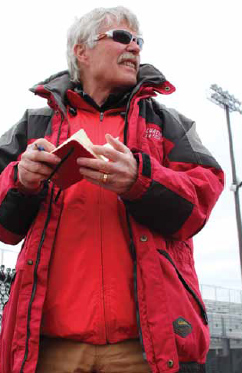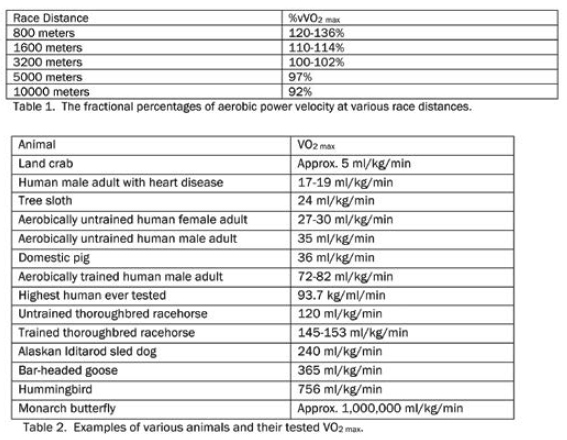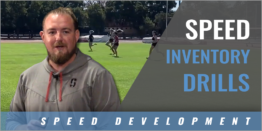|
Aerobic Power By: Scott Christensen Originially Published in: Techniques Magazine; Provided by: USTFCCCA
The anaerobic energy system is improved with maximum, and near maximum velocity work. Gains in the system are made through neural improvement at the neuro-muscular junction, improved neuron-muscular biomechanics during maximum effort, and muscle cell changes allowing for greater drainage and tolerance of lactate and hydrogen ions. The energy contribution of the anaerobic system varies from 50 percent in the 800 meters to about 8 percent in the 5000 meters. The training emphasis of the anaerobic energy system is dictated by the preferred race distance of the athlete. The aerobic energy system contributes more than 50 percent of the energy needed to run a distance race at maximum race pace. The characteristics of the race distance will dictate the amount of aerobic training emphasis. Aerobic energy system development is centered on the physiological concept of aerobic power or what is commonly known as VO2 max velocity (vVO2 max). Aerobic power is simply the amount of oxygen that can be used by the working muscles of an organism over a prescribed time at full aerobic effort. The work time measured is generally between 5-10 minutes whether on a treadmill in the lab or out on the workout course. The results are then standardized as a per minute value of oxygen usage per kilogram of body weight. This methodology allows the data to be compared from animal to animal or human to human. Since the lab test and field test have both a time and distance component, then velocity at maximum aerobic power effort can also be calculated. Improvement by the distance runner in training of this aerobic power velocity value translates to faster times in every race distance because aerobic power is a known fractional characteristic of all distance races. (See Table 1)
Running economy, which is the efficiency in which the distance runner uses food energy and oxygen in movement, is influenced by aerobic power because economy is heavily dependent on greater blood flow to the muscles. Running economy improves with vVO2 max training as does lactate threshold velocity. Improving aerobic power means developing a bigger heart, greater stroke volume, increased capillary beds, greater total blood volume and increases in mitochondria and enzymes. All of these are linked to improved running economy which can be thought of as simply the energy cost of movement. Aerobic power is considered the best quantitative measure of aerobic fitness. Commonly known as just VO2 max, it is useful for the running coach to determine what velocity is associated with present day aerobic power development in an athlete at that moment in time. Once the vVO2 max is determined it can be used to structure aerobic training loads and intensities in training units. The use of oxygen during aerobic metabolism rarely reaches a maximum in the average person. A human has to get within 88-90 percent of maximum heart rate to reach maximum oxygen use, however distance runners frequently reach such a threshold. Aerobic power and its correlated velocity can be determined during a treadmill test in the physiology lab. However, a field test over an exhaustive two mile run can be used to determine velocity at VO2 max which is the most important value for in any middle distance runner's profile. The lab value will determine milliliters of oxygen metabolized by each kilogram of body tissue per minute at maximum effort at about two mile pace. It has been shown that the VO2 max value is influenced by three variables: the genome of the individual, the maturity of the individual, and the aerobic fitness of the individual. An average untrained adult has a maximum value of about 35m1/kg/min of oxygen consumption. This value is rather low in comparison to other animals and reflects the non-migratory, walking lifestyle of humans. (See Table 2) The Fick equation is: VO2 max = left-side ventricular stroke volume (SV) x heart rate (HR) x amount of oxygen removed from blood at muscle (aVO2). Through specific training, VO2 max can increase because of central development, which is concentrated in structural changes to the heart and building a greater blood volume. While HR improves little through any sort of training, SV can improve dramatically. Aerobic training has been shown to increase the size of the heart, especially the left-side ventricle. The more oxygenated blood that leaves the heart towards the working muscles while running, the greater the improvement in running performance at sub-maximal speed. The training concern is the vast amount of time needed to increase the volume of the heart. The VO2 max equation (Fick equation) is also is influenced by the amount of oxygen extraction at the muscle. The equation indicates that VO2 max increases if more oxygen can be delivered by the heart and blood, and extracted by the muscle cells. The extraction variable can also be increased through specific training. Increases shown in VO2 max are thus influenced by peripheral development as well as central development. Peripheral factors are concentrated at the muscle-circulatory interface. It is both structural and bio-chemical in nature. Structurally, it involves synthesizing a greater capillarization network of beds touching the muscle. Some studies have shown an increase from two capillaries along a single muscle fiber in untrained humans to as many as seven capillaries along each muscle fiber after 27 weeks of specific training. The myoglobin content of the cell also increases as does the mitochondrial numbers within each muscle cell. Studies have shown a 2.5 times increase in mitochondrial numbers after 20 weeks of specific training. It has also been shown that aerobic enzyme quantity also increases in conjunction with structural changes. General aerobic fitness and specific aerobic power both improve as VO2 max increases through training. Running velocity increases at a higher VO2 max value because the body is able to utilize a greater amount of oxygen. It is simple algebra, but the training is far from simple. Documented training schemes designed to improve aerobic power (vVO2 max) in distance runners were first described by the Soviet Sports Institute in the 1970's. Besides the Eastern Bloc countries, one of the athletics organizations to quickly pick up on the concept was the British Milers Club in the early 1980's. Frank Horwill, and a bit later Peter Coe, were two of the coaches to understand the value in improving aerobic power with very specific stimulus applications. Meanwhile, in the United States, David Costull PhD, David Martin PhD, Joe Vigil, PhD and Jack Daniels PhD were working distance runners through aerobic power training schemes and documenting their progress by rigorous application of the Scientific Method. These pioneers have shaped the modern day training protocol addressing improvement in aerobic power.
Since the early days, it was theorized that aerobic power development was but one of four training domains used in preparing distance runners. Consider the standard track events of the 800 meter meters to the 10,000 meters. All of these are combined zone races to a degree. Anaerobic energy system development hinges on increasing lactate tolerance, while aerobically the three domains are: improving running economy, shifting the lactate threshold and boosting aerobic power. These four domains have varying influence based on the distance of the race. In races from the 1600 meters to the 6000 meter race in cross country, aerobic power is the major training stimulus used in affecting performance. Aerobic power training sessions can be either continuous efforts or interval style in design. Aerobic power directed workloads are most effective if run precisely at date pace vVO2 max. Since this marker presumably improves as fitness improves during the macrocycle it is a progressive value that must be closely monitored for each runner. It is recommended that vVO2 max markers be updated once every three weeks with either a quantitative field test or a race that is comparable to their vVO2 max. Each runners date pace vVO2 max value should be part of their individual's athletic profile that is then used to structure many different aerobic training sessions. The total volume for each aerobic power training session should be within the range of 2400 meters to 6400 meters. The only exception may be an occasional 1600 meter total volume session during the tapering portion of the competitive training phase. If done as intervals, aerobic power work should always have a work to rest time ratio of 1:1 to insure a proper end of the session stimulus. Since vVO2 max varies from individual to individual, the recovery interval becomes problematic in a large and diverse training group. With clever administration and monitoring of the group these problems can be minimized. Since aerobic training loads are intensely done at an energy system contribution of 87 percent aerobic and 13 percent anaerobic, a race day warm-up of at least three miles is recommended, with all the dynamic movement diversity need to be ready to run at that velocity from the word go. Aerobic power training sessions must be done at least once during each microcycle while in season. Aerobic power training sessions done as a continuous effort: A continuous run at vVO2 max serves two purposes: it can be used as a date pace aerobic power fitness field test, or in practice it can be implemented as the single training stimulus itself. The single effort can never exceed 3200 meters in length. If the training theme for the day is to update the vVO2 max field test, then it must be treated as a 2 mile race among teammates at full effort. Once the final times are recorded for all of the runners, each effort can be cut in half to determine present day vVO2 max pace and the data can be placed in the updated individual athlete profile. As a training session, a single continuous effort done at vVO2 max could vary from 2400 meters to 3200 meters. These workouts are typically done on foul weather days or during the tapering period in order to minimize time at practice. It is also an appropriate developmental workout for novice runners. The pace should be done precisely at date vVO2 max. There is no recovery interval to address, so a 4-5 mile continuous effort at gentle aerobic threshold pace could be added after the hard effort to supplement the workout. Aerobic power training sessions done as interval style efforts: An interval style aerobic power training unit allows more than 3200 meters of total volume to be done for the training session. The work can vary from many repeats at 400 meters to a couple of repeats of 3200 meters. The more the repetitions, then the more the recovery intervals which again must be closely monitored with a work to rest ratio of 1:1. The total volume of the session rarely exceeds 6400 meters, but can go as high as 8600 meters in experienced runners, Aerobic power workloads require a 48 hour recovery before a similar stimulus can be applied. A few example training units can be found in Table 3.
Aerobic power training sessions are cornerstone workouts for distance runners in the 800-6000 meter events. In races of this length the ability to utilize oxygen by the athlete is the limiting factor. Aerobic power training sessions are designed to improve the maximal use of oxygen. Years of scientific research have outlined to the coach the precise parameters of the aerobic power training stimulus that should be applied to gain the greatest VO2 max development in the least amount of time. Training should always follow the direction that the characteristics of the event shape the training sessions. Top qualityVO2 max training involves applying stimuli to both the central and peripheral areas of the system. Central development can be accomplished with many activities. The long run, LT run, tempo run and general base mileage volume work has great influence on central development. Peripheral development is a different story. Studies have shown that peripheral development is best accomplished with training velocities right at present day vVO2 max pace. Developing VO2 max is crucial in making distance runners faster. It is important to understand that both central and peripheral factors must be improved to fully be effective training. Workouts stressing VO2 max must be highly individualized, closely monitored and complex. They are well worth the time and effort in fully developing aerobic power in middle distance runners and especially the mile. Physiologists have given coaches considerable information on the concept of aerobic power. Scientific evidence shows that all aerobic races are shaped by aerobic power and its development both before and after the runner reaches genetic maturity. It is important these principles are applied to developing distance runners. o
Bio: Scott Christensen has been the Boys Cross Country and Track & Field Coach at Stillwater High School for over 30 years. He currently heads up the USTFCCCA Track & Field Academy's Endurance program and serves as the programs lead instructor.
|



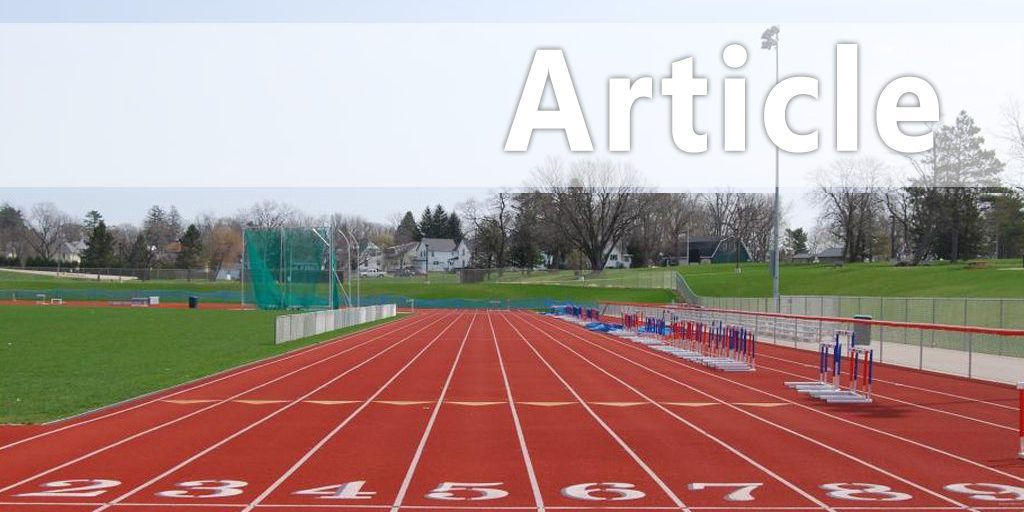
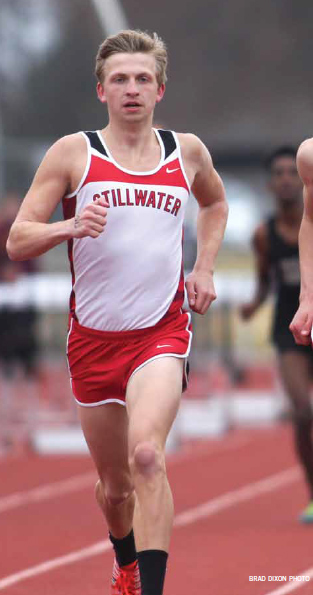 All of the standard distance races including cross country are combined zone races. Combined zone means energy needed for muscular contractions at race pace is derived from both the aerobic and anaerobic energy systems in combination. Improvement in both the capacity and efficiency of these independent energy systems, and how they work in tandem, is the reason distance runners train.
All of the standard distance races including cross country are combined zone races. Combined zone means energy needed for muscular contractions at race pace is derived from both the aerobic and anaerobic energy systems in combination. Improvement in both the capacity and efficiency of these independent energy systems, and how they work in tandem, is the reason distance runners train. Using vVO2 max as the index value, it is logical that as that number improves with training so do the linked fractional unit percentages at the other race distances. Using Table 1 data, one can determine that the race distance most associated with maximum aerobic power is the 3200 meter run. As fitness improves the percentage values shown do not change, but the associated velocity at each distance improves. As an example, at the start of the year a runner can run 11:00 for 3200 meters to exhaustion, or about 5:30 pace for each mile. The projected mark for the 1600 meters based on Table 1 should be 4:55. This index value is their current velocity at VO2 max, but as the season moves on so does the 3200 meter mark. Soon the athlete can run 10:30 or 5:15 pace for 3200 meters. Again referring to Table 1, the projected mile velocity at this new time should now be 4:41. The same velocity changes should occur for every race distance shown. The key in aerobic training is in improving the aerobic power value since that is the index value that physiologists have shown to be a key mark in aerobic fitness.
Using vVO2 max as the index value, it is logical that as that number improves with training so do the linked fractional unit percentages at the other race distances. Using Table 1 data, one can determine that the race distance most associated with maximum aerobic power is the 3200 meter run. As fitness improves the percentage values shown do not change, but the associated velocity at each distance improves. As an example, at the start of the year a runner can run 11:00 for 3200 meters to exhaustion, or about 5:30 pace for each mile. The projected mark for the 1600 meters based on Table 1 should be 4:55. This index value is their current velocity at VO2 max, but as the season moves on so does the 3200 meter mark. Soon the athlete can run 10:30 or 5:15 pace for 3200 meters. Again referring to Table 1, the projected mile velocity at this new time should now be 4:41. The same velocity changes should occur for every race distance shown. The key in aerobic training is in improving the aerobic power value since that is the index value that physiologists have shown to be a key mark in aerobic fitness.